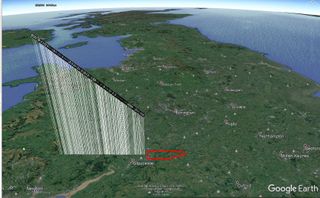A fireball blazed across the skies of southern England Sunday night (Feb. 28), and it likely dropped singed hunks of cosmic rock on the countryside below.
The brilliant yellow-green meteor, which flared up shortly before 10 p.m. local time Sunday, was seen by observers as far away as Ireland and the Netherlands, according to scientists with the UK Fireball Alliance (UKFall). It was a feast for the ears as well as the eyes, generating a sonic boom that rippled across southern England.

"The video recordings tell us its speed was about 30,000 miles per hour [48,300 kph], which is too fast for it to be human-made space junk, so it’s not an old rocket or satellite," planetary scientist Ashley King, of UKFall and the Natural History Museum in London, said in a statement.
"The videos also allowed us to reconstruct its original orbit around the sun," King added. "In this case, the orbit was like an asteroid's. This particular piece of asteroid spent most of its orbit between Mars and Jupiter, though sometimes got closer to the sun than Earth is."
Fireballs, spaceships, iguanas: 7 strange things that fell from the sky in 2020

Excitingly, some pieces of the asteroid's charred corpse probably made it to the ground.
"This meteor fragmented a lot, as you can see in the videos. Most of the meteoroid vaporized during the six seconds of visible flight," meteorite scientist Luke Daly, of UKFall and the University of Glasgow in Scotland, said in the same statement.
Get the Space.com Newsletter
Breaking space news, the latest updates on rocket launches, skywatching events and more!
"However, with this one, we think quite a few fragments probably reached the ground," Daly said. "If pieces landed, they are likely to have been on or just north of Cheltenham, out toward Stow-on-the-Wold. So most pieces are likely to be on farm land."

If you find what may be a piece of this meteorite fall, "ideally photograph it in place, note the location using your phone GPS, don't touch it with a magnet, and, if you can, avoid touching it with your hands," planetary scientist Katherine Joy of the University of Manchester said in the statement. "Pick it up in a clean bag or clean aluminium foil if possible!"
UKFall operates more than 30 fireball cameras across the United Kingdom. Sunday night's event was spotted by six of them — those at Cardiff, Manchester, Honiton, Lincoln, Cambridge and Welwyn Garden City, representatives of the organization said.
Mike Wall is the author of "Out There" (Grand Central Publishing, 2018; illustrated by Karl Tate), a book about the search for alien life. Follow him on Twitter @michaeldwall. Follow us on Twitter @Spacedotcom or Facebook.
Join our Space Forums to keep talking space on the latest missions, night sky and more! And if you have a news tip, correction or comment, let us know at: community@space.com.

Michael Wall is a Senior Space Writer with Space.com and joined the team in 2010. He primarily covers exoplanets, spaceflight and military space, but has been known to dabble in the space art beat. His book about the search for alien life, "Out There," was published on Nov. 13, 2018. Before becoming a science writer, Michael worked as a herpetologist and wildlife biologist. He has a Ph.D. in evolutionary biology from the University of Sydney, Australia, a bachelor's degree from the University of Arizona, and a graduate certificate in science writing from the University of California, Santa Cruz. To find out what his latest project is, you can follow Michael on Twitter.
Most Popular


